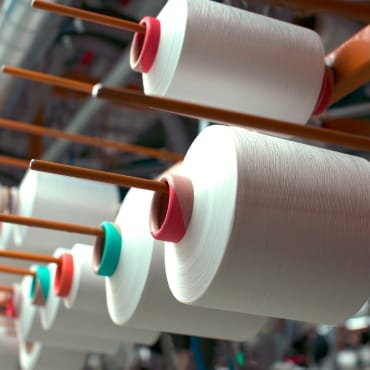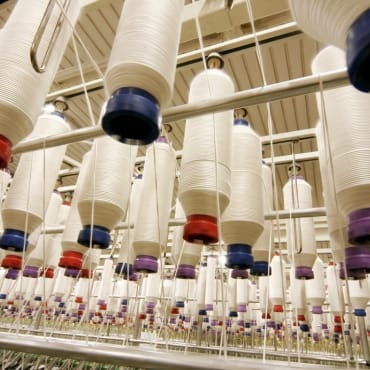Polyester yarn is all over the place. It’s found in curtains, clothes bags, even bedding sheets. But where do they begin? It starts with something quite typical–PET. PET stands for Polyethylene Terephthalate . You’ve likely noticed PET inscribed on bottles of water made from plastic. Surprising, right?
The plastic can’t remain in bottles. It is transformed into something amazing: PET Polyester Yarn. It is incredibly very soft, sturdy and extremely useful. The process of transitioning to PET into yarn a whirlwind of engineering, science, and savvy design. Let’s have a closer look.
Table of contents
- What Is PET Polyester Yarn?
- Importance of PET in the Textile Industry
- PET Chips: The Starting Point
- Melting and Extrusion of PET
- Cooling and Solidification
- Drawing the Filament: Strength and Stretch
- Winding the Yarn: Organizing the Threads
- Types of PET Polyester Yarn Produced
- Key Machines Used in Yarn Production
- Differences Between POY and FDY
- PET Polyester Yarn vs Nylon Yarn
- Global Production Hubs for PET Yarn
- How Recycled Bottles Become Yarn
- Modern Innovations in Yarn Making
- Packaging and Shipping Process
- Conclusion
- FAQs
What Is PET Polyester Yarn?

PET Polyester Yarn is a synthetic fiber made by spinning PET. The plastic is transformed into thread-like substances, which are then spun into fabric. Simple, isn’t it?
However, don’t let it fool you. It’s an effective product. PET yarn is well-known for its the strength, elasticity and resistance to wear. It also dries quickly. This makes it ideal for home textiles, sportswear as well as industrial fabrics.
Importance of PET in the Textile Industry

Why do we use PET in textiles? It’s because it’s affordable and durable. It’s also easy to manufacture. It is a substitute for natural fibers like wool and cotton in a lot of instances. PET-based yarn can also be recycled. It’s a major win for sustainable.
Industries are in love with PET yarn as it performs very well. It is resistant to stretching and wrinkles. It also blends well along with the other types of fibers.
PET Chips: The Starting Point

Every story starts somewhere. In the case of PET Polyester Yarn, the beginning point is PET chips. To begin with, manufacturers make these tiny plastic pellets from purified terephthalic acid and ethylene glycol. Don’t worry though. After all, these pellets are just the raw materials.
The chips are either white or slightly transparent. They’re hard, but they melt quickly. Prior to anything else it is dried to eliminate the moisture. This can cause problems in the following steps.
Melting and Extrusion of PET

The next step, naturally, is melting. First, the dry PET chips are heated to 260°C (500°F). At this stage, the temperature is high enough to melt the plastic. Once melted, the PET is then ready for extrusion.
Next comes the extrusion process. It involves pushing the melted PET through tiny holes. These holes, in turn, are part of a machine called the spinneret. As a result, the molten PET appears in fine strings.
Imagine a spaghetti machine. It’s a similar concept. These strands of long hair are now prototype-yarns.
Cooling and Solidification
When PET leaves the spinneret and enters cool air, the system steams the liquid strands and turns them into threads. The threads then fall onto a stationary belt or get collected in tanks.
This stage is crucial. Why? Because it determines the texture of the yarn and its strength. A mistake in this area can result in brittle or weak yarn.
Drawing the Filament: Strength and Stretch
Then we can stretch the yarn. This is known as the drawing. It increases the strength and elasticity. Imagine pulling a rubber band. Pulling is aligning the molecules within.
The drawn yarn is now more sturdy, making it less fragile. As a result, this gives PET Polyester yarn its distinctive strength and flexibility.
Winding the Yarn: Organizing the Threads
The yarn is drawn, and then it gets into the winding machine. Next, the machines wrap the yarn around cones or spools. This process is done in layers, ensuring it is neat and uniform.
The storage is made easier and transportation more convenient. The process also helps to prepare the yarn for future knitting or weaving.
Types of PET Polyester Yarn Produced
PET yarn isn’t only one type. There are many types of PET yarn:
| Type | Meaning | Use |
|---|---|---|
| POY | Partially Oriented Yarn | Draw Texturing Yarn (DTY) |
| FDY | Fully Drawn Yarn | Weaving and Knitting |
| DTY | Draw Textured Yarn | Garments, Socks, Linings |
| HOY | Highly Oriented Yarn | Sports and Outdoor Gear |
Each has its own unique arrangement and use.
Applications of PET Polyester Yarn
PET Polyester Yarn shows up in:
- T-shirts, athletic wear and other clothing
- Curtains and upholstery
- Bags and backpacks
- Car interiors, seat belts and seats
- Carpets and furniture for the home
It’s an integral regular part of our life.
Advantages Over Natural Fibers
In comparison to wool or cotton, PET yarn wins on several fronts:
- Dries quicker
- More durable and stronger
- Shrink-resistant
- Affordable
- It is less prone to wrinkles.
It’s the reason it’s a popular material in all industries.
Recycled PET in Yarn Production
Recycling can give PET an opportunity to live again. Plastic bottles used for cleaning can be cleaned, shredded, and then turned into chips. The chips undergo the same process of making yarn.
recycled PET polyester reduces the amount of plastic waste. It also reduces carbon emissions. A lot of eco-friendly companies are currently using this approach.
Quality Control in PET Polyester Yarn Plants
The quality is checked at every stage. Factories test yarn for:
- Diameter congruity
- Color quality
- Durability and strength
- Stretch and shrinkage
It is common to take samples. Recycled yarn is used not thrown away.
Key Machines Used in Yarn Production
| Machine | Function |
|---|---|
| Dryer | Removes the moisture from PET |
| Extruder | The melts and pushes PET |
| Spinneret | Forms yarn filaments |
| Quenching Chamber | Cools yarn strands |
| Drawing Machine | The yarn is stretched and aligned |
| Winder | Wraps yarn on cones |
The machines are in sync.
How Temperature Affects Yarn Properties
High temperatures melt PET. Cooling hardens it. However, even minor variations in temperature can be detrimental.
How fast is too cool? If it’s too fast, the yarn turns hard and brittle. Moreover, when it’s stretched too quickly, the yarn becomes too thin. That’s why precise control is essential.
Role of Additives in PET Yarn
Additives improve the performance of yarn. They:
- Improve dyeing
- Enhance UV resistance
- Create yarn that is stiffer or softer
- Control static buildup
If you do not treat the yarn with additives, it might not be able to meet the demands of the industry.
Coloring and Finishing Techniques
It is possible to add color two ways:
- Dope Dyeing: Color mixed during melting
- Post Dyeing Add color after the yarn is created
There are pros as well as pros and. Dope dyeing is a great way to save water; however, post-dyeing provides the possibility of more colors.
Differences Between POY and FDY
| Feature | POY | FDY |
|---|---|---|
| Processed? | Partially | Fully |
| Usage | Texturing | Direct use of fabric |
| Texture | Soft | Smooth |
PET Polyester Yarn vs Nylon Yarn
PET yarn is cheaper. Nylon is more flexible. PET is more resistant to water. Nylon wears down more quickly. It depends on the usage the material is suited to, as it may be more effective compared to the others. Read more Cheap Polyester Fabric That Looks Expensive
Global Production Hubs for PET Yarn
The major producers are:
- China (largest)
- India
- South Korea
- Turkey
- Taiwan
These countries have huge PET yarn production industries.
Environmental Impacts of PET Yarn
Like the other synthetics, PET yarn is not without some impact. It is made of petroleum. Recycling can help reduce harm. The new processes are also designed to reduce emissions.
Sustainability of PET Yarn
Many companies today use the rPET–recycled polyester. Brands such as Adidas and H&M are promoting environmentally friendly yarns. The market is changing slowly, but steadily.
How Recycled Bottles Become Yarn
- Collect bottles that are used
- Clean and dry
- Shred into pieces
- Form chips and melt
- Convert the yarn into chips
That’s it! From waste to textile.
Modern Innovations in Yarn Making
Technology is now improving:
- Energy use
- Recyclability
- Yarn’s softness
- Antimicrobial properties
The future of PET yarn is driven by innovation. PET yarn.
Cost Factors in Yarn Production
Costs will vary based on:
- Prices for raw materials
- Energy usage
- The cost of labor
- Additives and dyes
The efficiency of your business is the key to success.
Tips for Selecting Quality PET Yarn
Check for:
- Smooth texture
- Even color
- Consistent thickness
- Suppliers that are trusted
Poor yarn makes for poor fabric.
PET Yarn and Blends: Cotton, Viscose & More
PET is well-suited to:
- Cotton (for for)
- Viscose (for the softness)
- Lycra (for stretch)
These blends boost the performance.
Packaging and Shipping Process
The yarn is then packed into cones. Then, it is sealed with plastic. Pallets or boxes are the preferred storage options. Storage that is controlled by climate is recommended to prevent the possibility of moisture.
Future of PET Polyester Yarn
The future is green and intelligent. In addition, recycling yarns, low-energy production, and smart fabrics (like temperature-responsive fabric) are leading the way.
Conclusion
PET Polyester is much more than simply thread. It’s innovation at work. It starts out as plastic but transforms into fashion, safety equipment, and household items. It’s durable, affordable and becoming more environmentally friendly. It’s a world that PET yarn is growing rapidly and is becoming more eco-friendly. Read more Premium Polyester Fabric Guide: Uses, Benefits & Care Tips
FAQs
Clothing, home textiles, industrial applications, and more.
Yes, it can be made from and turned back into recycled materials.
From PET chips via melting, spinning, and drawing processes.


